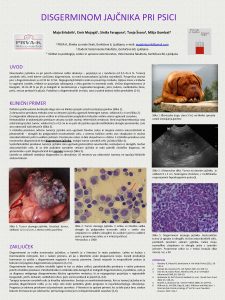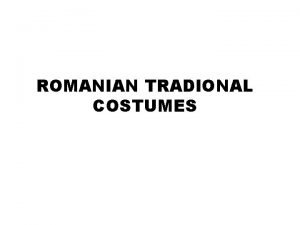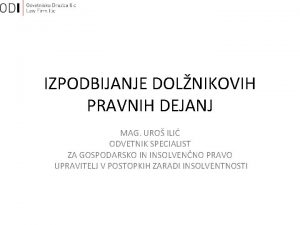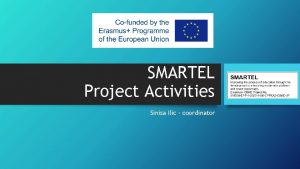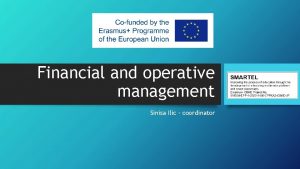Activity plan for the next period Sinisa Ilic











- Slides: 11

Activity plan for the next period Sinisa Ilic - coordinator

Assign members of PMB / SC / QB • Project management will focus on how the project is progressing in terms of expenditure, use of resources, implementation of activities, delivery of results and the management of risks. In order to achieve defined goals of the project, the project team will systematically collect, analyse and use relevant information about project progress. Regular reviews will provide an opportunity to reflect on progress, agree on the content of progress reports and follow-up action required. Intensive communication is the critical factor in efficient and effective leadership. • Project management structure will be defined and organised on 2 separate levels with intensive and defined connections and interfaces between these two levels in order to achieve proper project management. • The major decision-making body of the project will be the Steering Committee (SC). Steering committee will consist of one of most experienced representative of each EU and Partner countries institution in management. The tasks of SC will be to decide on actions to be taken when issues (challenges) appears. • PMB will coordinate day-to-day management in order to activities be completed according to the plan. Members of PMB will consists of one representative per partner institution and they will communicate among themselves in order to monitor execution of tasks. • PMB will meet four times a year, while SC will meet twice a year. Between "live" meetings, online meetings will be held whenever necessary. • The Project Quality Monitoring and Control Team (PQMC) will be responsible for preparing the guide for quality control and monitoring activities. PQMC members will continuously monitor project activities and will hold a PQMC meeting every four months on which they will define the internal control reports of the project. Members of PQMC will regularly cooperate with local Erasmus + offices.

Output: Multimedia Learning Platform • The realization of a multimedia learning platform for learning would include: • availability of teaching material in electronic form and electronic library, • video presentation of teaching and laboratory exercises, • live-streaming of significant university scientific and educational events, • integration of text, table, chart, image, sound, animation, hypertext, interactive content and complete software tools, • student participation in lecturing and lab exercises from any location and at any time, • teaching content adapted for disabled students (subtitling and speech synthesis).

Output: Smart Classroom for remote branches • A smart classroom for teaching would mean: • a modern equipped classroom with modern technologies applied in e-education: smart educational environments, Internet intelligent devices, a virtual learning environment, virtual reality technologies, mobile technologies, etc. , • the possibility of interactive participation of students in the realization of classes, • the ability to attend classes for students with special needs (subtitling and speech synthesis), • individual adaptation of teaching content to students, • Networking a smart classroom with other higher education institutions in the world. • The equipment in the classroom would allow streaming lectures on the multimedia platform. Each HEI would define the concept of their smart classroom in accordance with their needs and in accordance with already existing e-learning platforms. A smart classroom would be equipped with a classroom management software that allows interaction between teachers and students during teaching and student supervision by teachers.

Output: Innovative Pedagogical Approaches and Learning Methodologies • Strategy, • Existing Learning Methodologies in EU • Toward accreditation of distance learning study programmes

Outputs related to objectives • The implemented state of the art multimedia learning platform and the realized smart classroom will enable active attending of students (who are unable to regularly follow the teaching at the HEI) to the teaching process. • Students will have the opportunity to attend their lectures from the University Centre from their homes or regional remote units, to actively participate in the teaching process, perform laboratory exercises from their computers, and be supervised by teachers from the university centre. • This will create opportunities for students with socio-economic problems and students in geographically distant and isolated areas to attend lectures through a developed multimedia learning platform and smart classroom. • Also, students with disabilities, which include weak-sighted, deaf and hard-of-hearing students, will have the opportunity to follow teaching activities through the multimedia platform in the form of sub-titled video material and speech synthesis.

WP 1 + WP 2 WP 1 (CESIE) • To accomplish deliverables D 1. 1 and D 1. 2 ASAP • To start creating draft for D 1. 3 - CESIE • To postpone study visit (D 1. 4) (Can UPM / UL / UM presents how the platform is used? Simulation) WP 2 (Uo. M(MT)) • D 2. 1 Defining the user requirements, (Apr-July): risk • D 2. 2 Prof. Bonanno can start drafting the methodology and pedagogical approaches with the help of CESIE (June-Oct 2021) • D 2. 3 & D 2. 4 Defining the models + Workshop (June-Sept) then external QC (Oct/Nov)

WP 3 + WP 5 + WP 6 + WP 7 WP 3 (UL) • D 3. 1 Defining the list of equipment? (Oct 2021 – Feb 2022) • Tender + specifications to be prepared • VAT & Customs Exemption preparation WP 5 (UPM) • D 5. 1 Development of the Quality Control plan • D 5. 2 Internal evaluation of the project WP 6 (IBCM) • D 6. 1 Social Networks • D 6. 3 Dissemination events WP 7 (SMO) • D 7. 1 Creation of sustainability Plan • D 7. 2 University-Business cooperation

Comments of the EACEA during the project evaluation • it does not provide sufficient details on the particular aspects of the survey, such as scale, timing and share of the respondents belonging to vulnerable groups. • The vision and the specific objective related to the inclusion of students with special needs (identified as the central target group) into studying programmes are not appropriately reflected in the planned activities and expected results per institution: the teaching content is planned to be adapted for students with disabilities for too few courses to make a significant change and the vision outlined a reality. • the descriptions of the expected results are not specific enough (new modules and customisation are not adequately addressed), and the success indicators are not entirely appropriate (three e-content items per course is not specific enough), in particular concerning the disadvantaged student groups.

Comments of the EACEA during the project evaluation • More quantitative indicators are needed in the LFM, and as already stated, it is not clear how e-content is measured (i. e. , 180 of e-content) • Risks related to engaging the core target groups of students (students with disabilities, disadvantaged students and the like) are not appropriately addressed, and in general, their engagement in most of the project activities is not adequately planned or pursued. • When defining the quantitative indicators of impact, the proposal is not clear how many students with disadvantaged background will benefit from the new technological solution. • The project is planning to attract businesses to support the sustainability of the venture but is not clear about how to attract them and what added value it can provide to them in order to sustain cooperation.

IDEAS?
 X.next = x.next.next
X.next = x.next.next Siniša faraguna
Siniša faraguna Psihologija komunikacije siniša brlas
Psihologija komunikacije siniša brlas Dr danijela filipović
Dr danijela filipović Master of health administration monash
Master of health administration monash Ilic romanesc
Ilic romanesc Uros ilic
Uros ilic Critical period vs sensitive period
Critical period vs sensitive period A&p flix activity: propagation of an action potential
A&p flix activity: propagation of an action potential When is the relative refractory period
When is the relative refractory period Critical period vs sensitive period
Critical period vs sensitive period Critical/sensitive periods
Critical/sensitive periods

